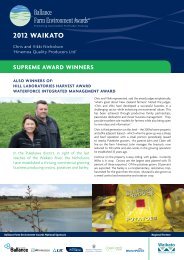Dairy's role in sustaining New Zealand - Fonterra
Dairy's role in sustaining New Zealand - Fonterra
Dairy's role in sustaining New Zealand - Fonterra
Create successful ePaper yourself
Turn your PDF publications into a flip-book with our unique Google optimized e-Paper software.
18 Dairy’s <strong>role</strong> <strong>in</strong> generat<strong>in</strong>g growth<br />
Where the money goes<br />
To illustrate the impact of dairy farmer spend<strong>in</strong>g <strong>in</strong> the <strong>New</strong> <strong>Zealand</strong> economy, Table 8 sets<br />
out the key cash flow items for an average dairy farm operation for the current 2010/11 June<br />
year. In the current year Dairy NZ expects the average dairy farm to produce around 130,000<br />
kg of milksolids. The cash <strong>in</strong>come is the dollar amount received for milksolids sold to the<br />
factory (i.e. <strong>Fonterra</strong>) and also <strong>in</strong>cludes net livestock sales.<br />
Table 8: Average farm cashflow<br />
$ per farm, $ per kg MS<br />
2010/11<br />
$ per kg MS<br />
2010/11<br />
$ per kg MS<br />
Cash Income 840,000 6.80<br />
Less farm work<strong>in</strong>g expenses 475,000 3.60<br />
Cash Operat<strong>in</strong>g Surplus 365,000 3.20<br />
Less<br />
Interest and rent 185,000 1.50<br />
Tax 35,000 0.25<br />
Draw<strong>in</strong>gs 85,000 0.70<br />
Cash available for development/<br />
<strong>in</strong>vestment/debt repayment<br />
60,000 0.75<br />
Apple and Pear Compet<strong>in</strong>g export -3.0%<br />
Sheep and Beef Compet<strong>in</strong>g export -0.4%<br />
Textiles Compet<strong>in</strong>g export -1.3%<br />
Note: Figures are rounded so do not exactly add up<br />
Source: Dairy <strong>New</strong> <strong>Zealand</strong> 2010<br />
A substantial part of farmers’expenses are the farm work<strong>in</strong>g expenses. Farm work<strong>in</strong>g<br />
expenses typically <strong>in</strong>clude wages, animal health and breed<strong>in</strong>g, feed made and purchased,<br />
stock graz<strong>in</strong>g fertiliser, expenditure on remov<strong>in</strong>g weed and pests, repairs and ma<strong>in</strong>tenance,<br />
fuel, vehicle charges, adm<strong>in</strong>istration, <strong>in</strong>surance, ACC, and rates.<br />
This leaves what is known as the cash operat<strong>in</strong>g surplus. This is less than half of the <strong>in</strong>itial<br />
cash <strong>in</strong>come. From this farmers pay off <strong>in</strong>terest and rent (this <strong>in</strong>cludes overdraft and term<br />
payments and also rent of land), tax (term<strong>in</strong>al and estimated tax), and draw<strong>in</strong>gs (family liv<strong>in</strong>g<br />
expenses). This leaves the cash available for farm development, any <strong>in</strong>vestments made and<br />
repay<strong>in</strong>g pr<strong>in</strong>cipal on debt.<br />
This demonstrates that most of the money received by farmers as their cash <strong>in</strong>come <strong>in</strong> one<br />
form or another is spent <strong>in</strong> <strong>New</strong> <strong>Zealand</strong>. This is of fundamental importance for the <strong>New</strong><br />
<strong>Zealand</strong> economy s<strong>in</strong>ce it drives further <strong>in</strong>come generation and has a major impact on<br />
domestic economic activity.
















